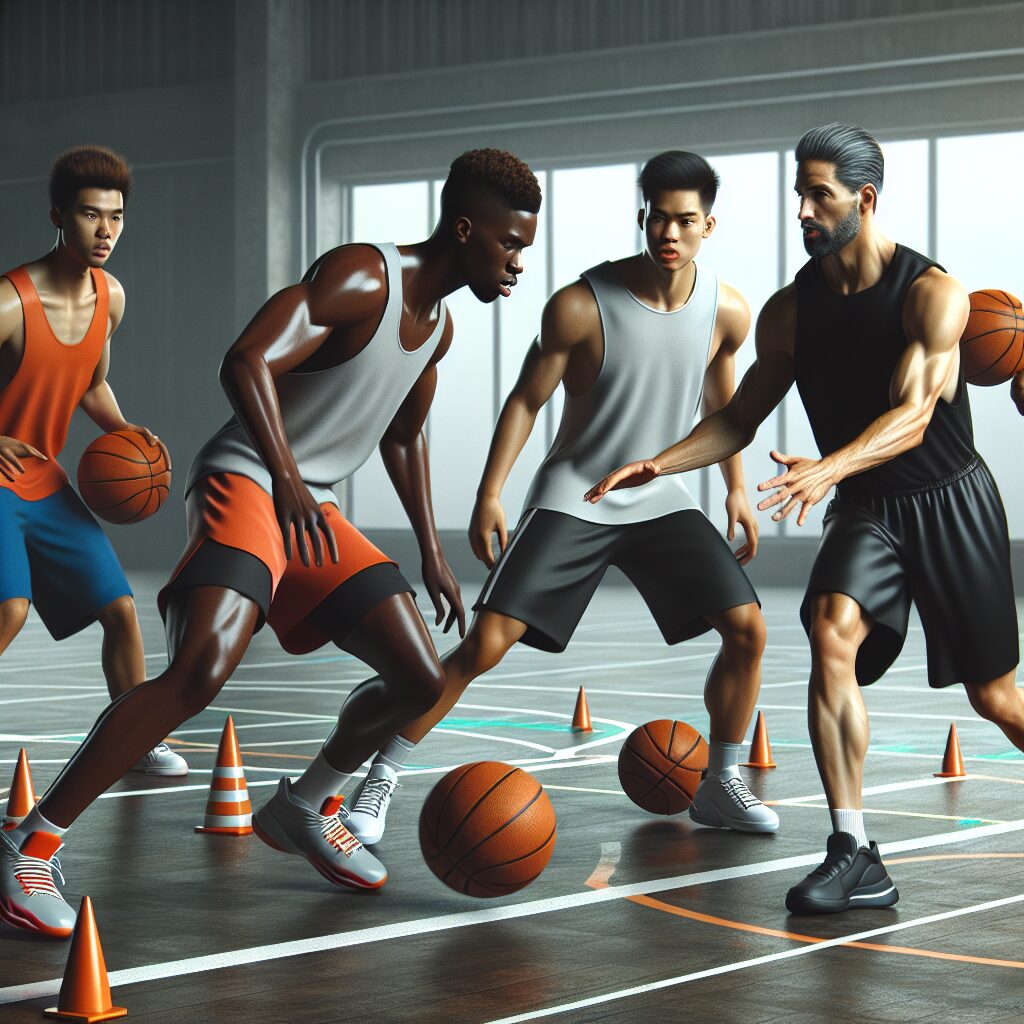Effective drills for improving ball handling are an essential component of basketball training, enabling players to enhance their skills and excel on the court. Ball handling refers to the ability to control and manipulate the basketball while dribbling, passing, and shooting. It is crucial for players to develop solid ball handling skills to maintain possession, make accurate passes, and create scoring opportunities.
One unique feature of ball handling drills is their versatility and adaptability to different skill levels. Whether you are a beginner looking to develop fundamental skills or an advanced player aiming to refine your techniques, there are drills available to suit your needs. These drills not only enhance hand-eye coordination but also improve overall basketball skills such as agility, speed, and decision-making abilities. By regularly practicing ball handling drills, players can develop muscle memory, allowing them to handle the ball effortlessly during intense game situations.
In the upcoming part of this article, we will discuss some key takeaways from effective ball handling drills that can be incorporated into your training regimen. These drills will focus on improving dribbling techniques, enhancing hand speed and coordination, and increasing overall ball control. By incorporating these key takeaways into your practice routine, you can elevate your ball handling skills and become a more dominant player on the basketball court. Stay tuned to discover the secrets of effective drills for enhancing ball handling prowess.
Key Takeaways
1. Consistent practice of ball handling drills improves hand-eye coordination and increases dribbling control, leading to better overall performance on the court.
2. Incorporating both stationary and dynamic drills, such as figure eight dribbles and cone drills, helps simulate game-like situations and enhances players’ ability to handle the ball under pressure.
3. Varying the difficulty of drills, through factors like speed and intensity, challenges players to push their limits and acquire new skills, ultimately enhancing their ball handling capabilities.
4. Combining ball handling drills with agility exercises, such as ladder drills and lateral movements, develops players’ quickness and agility, allowing them to better navigate the court and maintain control of the ball.
5. Emphasizing proper technique during ball handling drills is crucial, as it helps prevent injuries and ensures players develop good habits that can translate into improved performance during games.
What are the most effective drills for improving ball handling?
Importance of Ball Handling in Basketball
Ball handling is a fundamental skill in basketball that is vital for players of all positions. It involves dribbling, passing, and controlling the ball with precision and agility. Good ball handling enhances a player’s ability to maintain control, make accurate passes, and maneuver past defenders. It is a skill that can significantly impact a player’s overall performance on the court.
Finger Strengthening Exercises
One of the key aspects of improving ball handling is developing strong finger muscles. This can be achieved through specific exercises that target finger strength. Some effective drills for this include:
- Fingertip Push-Ups: By assuming a standard push-up position and shifting weight onto the fingertips, players can strengthen their finger muscles.
- Dribbling with Fingertips: Focusing on dribbling the ball using only the fingertips forces the fingers to exert more strength and control.
- Ball Squeezes: Squeezing a basketball with maximum force using the fingers and then releasing repeatedly helps in building finger strength.
Dribbling Drills
Improving ball handling involves mastering different dribbling techniques. These drills focus on developing control, speed, and ambidexterity. Some effective dribbling drills include:
- Two-Ball Dribbling: Practicing dribbling simultaneously with two basketballs helps improve coordination and ball control.
- Crossover Dribbles: Working on crossover dribbles by alternating the ball between hands enhances the ability to change directions quickly.
- Figure-Eight Dribbles: Dribbling the ball in a figure-eight pattern around the legs helps improve coordination and control.
- Stationary Dribbling Variations: Practicing dribbling with different heights, speeds, and rhythms while standing in one place helps develop overall ball handling skills.
Passing Drills
Effective ball handling is incomplete without proficient passing abilities. These drills focus on developing accuracy, timing, and court awareness. Some essential passing drills include:
- Partner Chest Passes: Standing face-to-face with a partner and passing the ball forcefully using the chest pass technique improves accuracy and strength.
- High-Low Passes: Practicing passing between high and low targets can enhance court vision and precision passing.
- Outlet Passes: Simulating game situations, players throw long passes to teammates down the court, improving speed and accuracy.
- Pick-and-Roll Passes: Working on passing while executing pick-and-roll plays enhances decision-making skills in real-game scenarios.
Ball Handling Drills in Motion
Combining ball handling with movement is crucial for game-like situations. These drills focus on incorporating dribbling, passing, and control while on the move. Some effective drills in motion include:
- Figure-Eight Around Cones: Setting up cones in a figure-eight pattern and dribbling through them at various speeds helps improve agility and ball control during motion.
- Full-Court Dribbling: Practicing full-court dribbling with controlled speed and maintaining control while navigating around defenders improves ball handling under pressure.
- Three-Man Passing Weave: Involving three players passing the ball while moving in a weaving pattern challenges hand-eye coordination and decision-making abilities.
- Penetration and Kick: Simulating penetration moves towards the basket and then passing to an open teammate helps improve court vision and decision making while in motion.
Conclusion:
Improving ball handling is a continuous process that requires dedication and practice. By incorporating these effective drills into training routines, basketball players can enhance their dribbling, passing, and overall ball control skills, leading to improved performance on the court.
- Practice dribbling with fingertips to strengthen finger muscles.
- Master different dribbling techniques like two-ball dribbling and crossover dribbles.
- Improve passing abilities through partner chest passes and high-low passes.
- Combine ball handling with motion by practicing figure-eight around cones and full-court dribbling.
- Regularly incorporate these drills into training routines for continuous improvement.
Frequently Asked Questions
1. What are some effective drills for improving ball handling?
There are various drills that can help improve your ball handling skills, such as the stationary dribbling drill, figure-eight drill, and two-ball dribbling drill. These drills focus on developing your dribbling technique, control, and coordination.
2. How often should I practice ball handling drills?
Consistency is key when practicing ball handling drills. Aim to practice these drills at least 3-4 times a week to see significant improvement. However, it’s important to give your muscles adequate time to rest and recover.
3. Can ball handling drills help with my overall basketball performance?
Absolutely! Effective ball handling drills not only improve your dribbling skills but also enhance your overall basketball performance. By developing better control and coordination, you’ll be able to maneuver through defenders, make accurate passes, and create scoring opportunities for yourself and your teammates.
4. Can ball handling drills be done alone?
Yes, many ball handling drills can be done alone. In fact, practicing solo can be highly beneficial as it allows you to focus solely on your technique and build muscle memory. However, it’s also beneficial to incorporate partner drills or game-based scenarios to practice dribbling under defensive pressure.
5. How long should each ball handling drill session last?
The duration of each ball handling drill session depends on your skill level and fitness level. It’s recommended to start with shorter sessions of about 15-20 minutes and gradually increase the duration as you progress. Remember to prioritize quality over quantity, focusing on proper technique and execution.
6. Can ball handling drills help improve hand-eye coordination?
Yes, ball handling drills are excellent for improving hand-eye coordination. These drills require you to be aware of the ball’s movement and react accordingly, enhancing your ability to track the ball and make quick decisions. Through consistent practice, your hand-eye coordination will significantly improve.
7. Are there any specific drills for improving ball handling for young beginners?
Yes, there are specific ball handling drills designed for young beginners. Simple drills like the stationary dribbling drill, fingertip control drill, and the snake dribble drill are great for young players to develop their basic ball handling skills and confidence.
8. How long does it take to see improvement in ball handling skills?
The time it takes to see improvement in ball handling skills varies from person to person. With consistent practice, it’s possible to see noticeable improvement within a few weeks or months. However, it’s important to remember that everyone progresses at their own pace, so stay patient and committed to the process.
9. Can ball handling drills be combined with other basketball training exercises?
Absolutely! Combining ball handling drills with other basketball training exercises like shooting, footwork drills, and conditioning drills can further enhance your overall basketball skills. By incorporating a well-rounded training routine, you’ll improve your performance both on and off the court.
10. Are there any safety precautions to keep in mind while practicing ball handling drills?
While practicing ball handling drills, it’s important to ensure a safe environment. Clear the area of any obstacles or hazards that may cause injuries. Additionally, remember to warm up properly before starting the drills to prevent muscle strains or any other potential injuries.
Final Thoughts
Developing effective ball handling skills is crucial for any basketball player, regardless of their position. By incorporating regular and focused ball handling drills into your training routine, you’ll not only enhance your dribbling abilities but also improve your overall performance on the court. Remember to stay consistent, patient, and dedicated to the process, as progress may take time. So grab your basketball, find a suitable training space, and start mastering those ball handling drills. Your improved skills will make a significant difference in your game!
In conclusion, effective drills for improving ball handling provide the foundation for enhanced control, coordination, and confidence on the basketball court. Whether you’re a beginner or an experienced player, the key is to practice regularly and with purpose. By dedicating time to specific ball handling drills, you’ll notice considerable improvements not only in your dribbling technique but also in your overall basketball performance. So, commit to the process, challenge yourself, and enjoy the rewarding journey of becoming a skilled and versatile ball handler.




